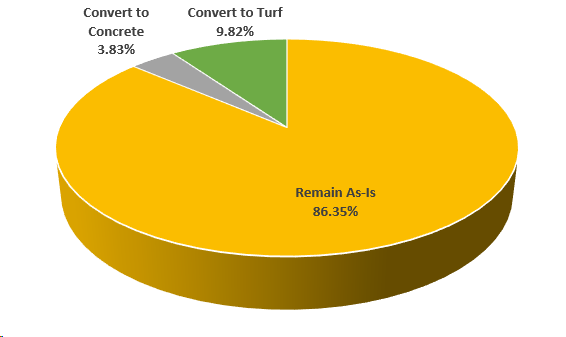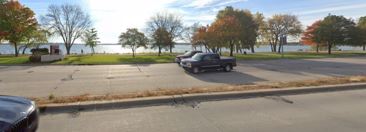Median Planting Bed Conversions - Frequently Asked Questions
posted

There is a lot of interest in the Engineering Division’s plan to convert a small percentage of median planting beds to concrete or turf. We’ve developed this FAQ document to address the questions we have been receiving from residents about this project.
View the map that shows which medians are affected.
General Information
How many median planting beds are being converted?
A total of 89 median planting beds are being converted to either concrete or turf. This is about 14% of the 652 planted medians citywide.
Where are these medians located?
The medians being converted are located in high traffic areas throughout the City. None of the medians being converted are located in residential neighborhoods.
Will any trees be removed?
No – converting these medians will not require any trees to be removed.
Why are these medians being converted?
There are a number of factors which drove this decision foremost of which is the very real budget constraints the City faced in putting its 2022 operating budget together and will continue to face in future years. Increasing maintenance costs and difficulty getting contractors to perform this work also factored into this decision.
These median conversions are supposed to save money, but doesn’t it cost more to remove the existing planting beds and replace with turf or concrete?
The cost to convert these medians is a one-time cost. Maintenance is an on-going cost that increases every year. Reducing on-going maintenance saves the City and our residents in the long-run.
Can I adopt one of the medians scheduled to be converted?
Unfortunately, no. These medians are all located in high traffic areas and due to safety issues we are not able to allow residents to adopt these medians. Please refer to our Median Conversion Location Map see the locations or medians to be converted. If you want to adopt a median located on a low traffic street visit Adopt-A-Median for more information.
Conversion to Concrete
How many medians are being converted to concrete?
Only 25 medians are being converted to concrete. This is less than 4% of the 652 planted medians citywide.
Why not plant the medians being converted to concrete with a native plant/low mow alternative?

These alternatives would reduce the frequency of maintenance but do not eliminate it. The 25 medians selected for conversion to concrete are all less than 6 feet wide and located in high traffic areas. These conditions make maintenance difficult at best and unsafe at worst. As such, even without budget constraints these median should be converted to concrete. Additionally, our success in converting existing medians to low mow vegetation has been hit and miss. We have had better success in new medians planted this way from scratch.
What is the impact on our lakes of converting these 25 medians to concrete?
The 25 medians being converted to concrete are located throughout the City. The changes in any one area are very small on a watershed basis.
Conversion to Turf
How many medians planting beds are being converted to turf?
Only 64 medians are being converted to turf. This is less than 10% of the 652 planted medians citywide.
Why not plant the medians being converted to turf with a native plant/low mow alternative?
The planted medians we are converting to turf are generally in medians that have a large turf presence. It wouldn’t make sense to convert just patches of these medians to low mow when the majority of the median is already turf. Additionally, our success in converting existing medians to low mow vegetation has been hit and miss. We have had better success in new medians planted this way from scratch.
How is the City Promoting Pollinator Habitat in its Medians?
The City is currently piloting a number of alternatives to traditional median plantings with a focus on native species to increase pollinator habitat and decrease maintenance:
- Low-Mow Bee Lawn: Twelve medians have been planted with a low-mow bee lawn which consists of a salt and drought-tolerant fescue mix and low-growing wildflowers such as Dutch Clover and Self-heal. This vegetative cover could support pollinators and reduce the need to mow medians by 80% as compared to typical turf grass.
- Native Shortgrass Prairie: Ten medians have been planted with native shortgrasses and wildflowers. In addition to being pollinator-friendly and beautiful, they are also lower maintenance than traditional planting beds.
- Mulch Alternatives: We are introducing hardy native groundcovers such as Canada Anemone (Anemone canadensis) and Wild Strawberry (Fragaria virginiana) to replace mulch. These groundcovers will help stifle weeds as well as provide resources for pollinators and reduce maintenance.
- Replacement Plantings: As plantings need to be replaced we are using native plants and feature species such as Butterfly Milkweed : Asclepias tuberosa) and Prairie Dropseed (Sporobulis heterolepis).
What Can I Do to Increase Pollinator Habitat and Reduce Run-Off?
Medians are a relatively small source of urban pollinator habitat. A potentially much larger source of urban pollinator habitat are private and public lawns. City of Madison agencies are already working to convert many underutilized turf areas into native plantings. There are number of ways residents can help improve our environment.
-
Adopt-A-Median: The Adopt-A-Median program is a program for Madison community members to take care and maintain existing traffic calming circles and medians located on low traffic streets throughout the City. The Adopt-A-Median program is just one way to get involved in improving public infrastructure, plus, it's easy to apply!
-
Build a Rain Garden: A rain garden is a great option for stormwater management as it temporarily rainwater runoff that flows from roofs, driveways, patios or lawns so it can soak into the ground. The “Roger Bannerman Rain Garden Initiative” provides grant funding and technical assistance to private property owners who would like to construct a rain garden in the terrace of their property associated with a street project.
-
Change your lawn care strategy. Mow your lawn less frequently and don’t use herbicides.
-
Convert your lawn to native plantings. Native turf grass can reduce your environmental footprint and provide habitat for birds and pollinators.
More Questions?
Email us at engineer@cityofmadison.com if you have questions or need more information.
